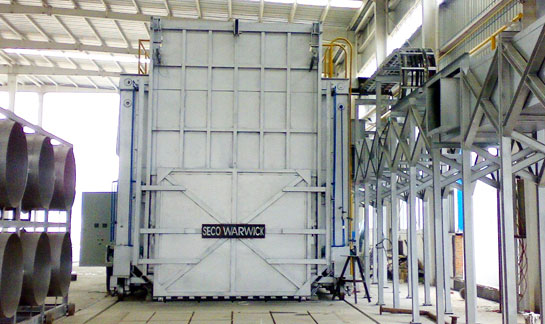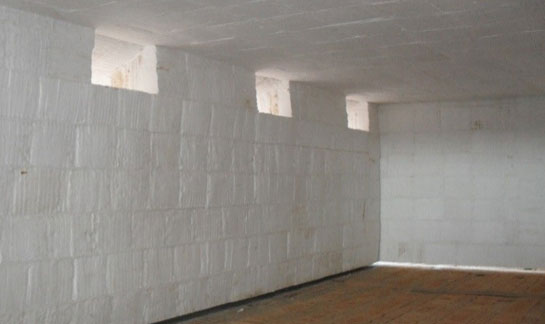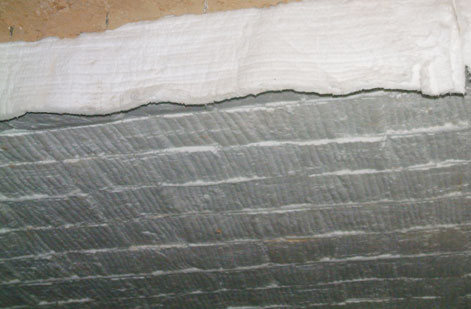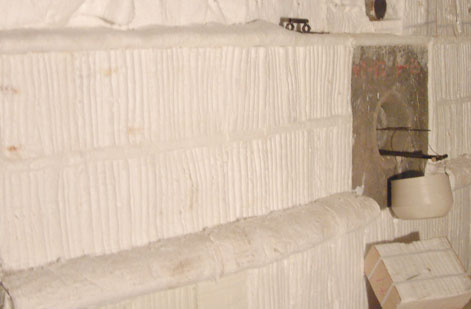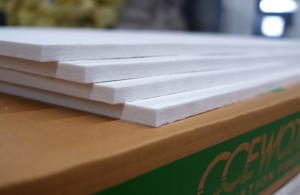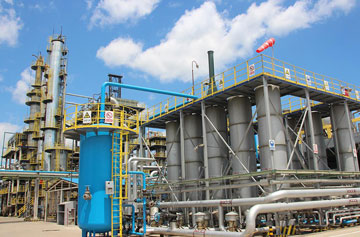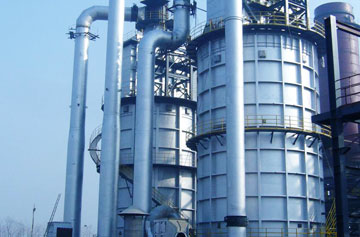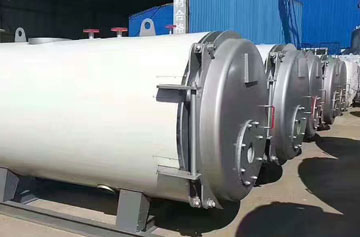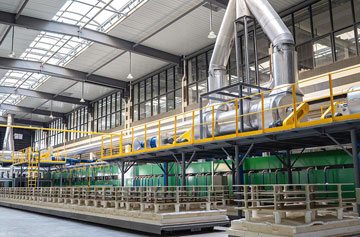Design and Construction of Continuous Hot-dip Galvanizing Annealing Furnace Lining for Strip Steel
Overview:
The hot-dip galvanizing process is divided into two categories: in-line galvanizing and out-of-line galvanizing based on different pre-treatment methods. The continuous hot-dip galvanizing annealing furnace for strip steel is an annealing equipment that heats the hot-dip galvanized original plates during the in-line galvanizing process. According to different production processes, strip steel continuous hot-dip galvanizing annealing furnaces can be divided into two types: vertical and horizontal. The horizontal furnace is actually similar to the general straight-through continuous annealing furnace, which consists of three basic parts: a preheating furnace, a reduction furnace, and a cooling section. The vertical furnace is also called a tower furnace, which is composed of a heating section, a soaking section, and a cooling section.
Lining structure of strip steel continuous annealing furnaces
Tower-structure furnaces
(1) The heating section (preheating furnace) uses liquefied petroleum gas as fuel. Gas burners are arranged along the height of the furnace wall. The strip steel is heated in the countercurrent direction of the furnace gas which presents a weak oxidizing atmosphere. The heating section (preheating furnace) has a horseshoe-shaped structure, and its top and the high temperature zone where the burner nozzles are arranged have high temperatures and high speeds of air flow scouring, so the furnace wall lining adopts lightweight refractory materials, such as CCEFIRE high aluminum light bricks, thermal insulation bricks, and calcium silicate boards. The heating section’s (preheating furnace) low temperature zone (strip steel entering zone) has a low temperature and low air flow scouring speed, so CCEWOOL ceramic fiber modules are often used as wall lining materials.
The wall lining dimensions of each part are as follows:
A. The top of the heating section (preheating furnace).
CCEFIRE high-aluminum lightweight refractory bricks are selected as the lining for the furnace top.
B. Heating section’s (preheating furnace) high temperature zone (strip tapping zone)
The high temperature zone’s lining is always composed of the following layers of materials:
CCEFIRE High Aluminum Lightweight Bricks (the hot surface of wall lining)
CCEFIRE insulation bricks
CCEWOOL calcium silicate boards (the cold surface of wall lining)
The low temperature zone uses CCEWOOL ceramic fiber modules (a volume density of 200Kg/m3) containing zirconium for lining.
(2) In the soaking section (reduction furnace), the gas radiant tube is used as the heat source of the strip reduction furnace. The gas radiant tubes are arranged along the height of the furnace. The strip runs and is heated between two rows of gas radiant tubes. The furnace presents reducing furnace gas. At the same time, the positive pressure operation is always maintained. Because the heat resistance and thermal insulation of CCEWOOL ceramic fiber are greatly reduced under positive pressure and reducing atmosphere conditions, it is necessary to ensure the good fire resistance and heat insulation effects of the furnace lining and minimize the furnace weight. Also, the furnace lining must be strictly controlled to avoid slag drop to make sure the surface of the galvanized original plate is smooth and clean. Considering the maximum temperature of the reduction section does not exceed 950 ℃, the soaking section’s (reduction furnace) furnace walls adopt a high-temp insulation layer structure of CCEWOOL ceramic fiber blankets or cotton sandwiched between two layers of heat-resistant steel, which means the CCEWOOL ceramic fiber blanket or cotton layer is paved between the two steel plates. The ceramic fiber interlayer is composed of the following ceramic fiber products.
The heat-resistant steel sheet layer on the hot surface uses CCEWOOL zirconium fiber blankets.
The middle layer uses CCEWOOL high-purity ceramic fiber blankets.
The layer next to the cold surface steel plate uses CCEWOOL ordinary ceramic fiber cotton.
The top and walls of the soaking section (reduction furnace) adopt the same structure as above. The furnace maintains a reducing furnace gas containing 75% H2 and 25% N2 to realize the recrystallization annealing of the strip steel and the reduction of iron oxide on the surface of the strip steel.
(3) Cooling section: The air-cooled radiant tubes cool the strip from the furnace temperature (700-800°C) of the soaking section (reduction furnace) to the zinc pot galvanizing temperature (460-520°C), and the cooling section maintains the reducing furnace gas.
The lining of the cooling section adopts the tiled structure of CCEWOOL high-purity ceramic fiber blankets.
(4) Connecting sections of the heating section (preheating furnace), the soaking section (reduction furnace), and the cooling section, etc.
The above shows that the annealing process of cold-rolled strip steel before hot-dip galvanizing needs to go through processes, such as heating-soaking-cooling, and each process is performed in different structure and independent furnace chambers, which are called the preheating furnace, the reduction furnace, and the cooling chamber respectively, and they constitute the continuous strip annealing unit (or an annealing furnace). During the annealing process, the strip steel continuously passes through the above-mentioned independent furnace chambers at a maximum linear speed of 240m/min. In order to prevent oxidation of the strip steel, the connecting sections realize the connection between the independent rooms, which not only prevents the strip steel from being oxidized at the joints of the independent furnace chambers, but also ensures sealing and heat preservation.
The connecting sections between each independent room use ceramic fiber materials as lining materials. The specific materials and structures are as follows:
The lining adopts CCEWOOL ceramic fiber products and the full-fiber structure of tiled ceramic fiber modules. That is, the hot surface of the lining is CCEWOOL zirconium-containing ceramic fiber modules + tiled CCEWOOL ordinary ceramic fiber blankets (cold surface).
Horizontal structure furnace
According to the different technological requirements of each part of the horizontal furnace, the furnace can be divided into five sections: a preheating section (PH section), a non-oxidizing heating section (NOF section), a soaking section (radiant tube heating reduction section; RTF section), a rapid cooling section (JFC section), and a steering section (TDS section). The specific lining structures are as follows:
(1) The preheating section:
The furnace top and the furnace walls adopt the composite furnace lining stacked with CCEWOOL ceramic fiber modules and ceramic fiber blankets. The low-temp lining uses a layer of CCEWOOL 1260 fiber blankets compressed to 25mm, while the hot surface uses CCEWOOL zirconium-containing fiber folded blocks. The lining on the high-temp parts adopts a layer of CCEWOOL 1260 fiber blanket, and the hot surface uses ceramic fiber modules.
The furnace bottom adopts the stacking composite lining of light clay bricks and ceramic fiber modules; the low-temp parts adopt the composite structure of light clay bricks and zirconium-containing ceramic fiber modules, while the high-temp parts adopt the composite structure of light clay bricks and ceramic fiber modules.
(2) No oxidation heating section:
The top of the furnace adopts the composite structure of ceramic fiber modules and ceramic fiber blankets, and the back lining adopts 1260 ceramic fiber blankets.
The common parts of the furnace walls: a composite furnace lining structure of CCEFIRE lightweight high-alumina bricks + CCEFIRE lightweight thermal insulation bricks (volume density 0.8kg/m3) + CCEWOOL 1260 ceramic fiber blankets + CCEWOOL calcium silicate boards.
The burners of the furnace walls adopt a composite furnace lining structure of CCEFIRE lightweight high alumina bricks + CCEFIRE lightweight thermal insulation bricks (volume density 0.8kg/m3) + 1260 CCEWOOL ceramic fiber blankets + CCEWOOL calcium silicate boards.
(3) Soaking section:
The top of the furnace adopts a composite furnace lining structure of CCEWOOL ceramic fiberboard blankets.
Post time: May-10-2021


